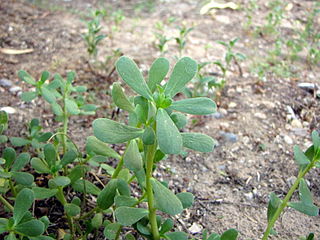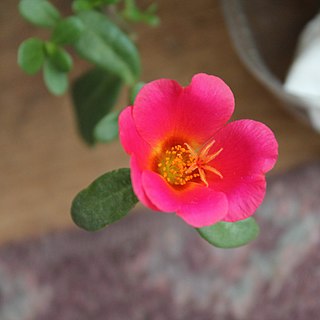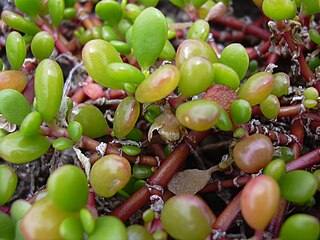
Crithmum is a monospecific genus of flowering plant in the carrot family Apiaceae, with the sole species Crithmum maritimum, known as rock samphire, sea fennel or samphire. The name "samphire" is also used for several other unrelated succulent halophyte species of coastal plant.

Portulaca oleracea is an annual succulent in the family Portulacaceae.

Portulaca is a flowering plant of the family Portulacaceae, with over 100 species, found in the tropics and warm temperate regions. Also the type genus of the family, portulacas are known as the purslanes.

The Portulacaceae are a family of flowering plants, comprising 115 species in a single genus Portulaca. Formerly some 20 genera with about 500 species, were placed there, but it is now restricted to encompass only one genus, the other genera being placed elsewhere. The family has been recognised by most taxonomists, and is also known as the purslane family. It has a cosmopolitan distribution, with the highest diversity in semiarid regions of the Southern Hemisphere in Africa, Australia, and South America, but with a few species also extending north into Arctic regions. The family is very similar to the Caryophyllaceae, differing in the calyx, which has only two sepals.

Ostrya is a genus of eight to 10 small deciduous trees belonging to the birch family Betulaceae. Common names include hop-hornbeam and hophornbeam. It may also be called ironwood, a name shared with a number of other plants.

Eryngium maritimum, the sea holly or sea eryngo, or sea eryngium, is a perennial species of flowering plant in the family Apiaceae and native to most European coastlines. It resembles a plume thistle in appearance on account of its burr-shaped flower. Despite its common name, it is not taxonomically related to true holly, but is an umbellifer.

Tripleurospermum inodorum, common names scentless false mayweed, scentless mayweed, scentless chamomile, and Baldr's brow, is the type species of Tripleurospermum. This plant is native to Eurasia and North Africa, and introduced to North America, where it is commonly found in fields, fallow land and gardens.

Pancratium is a genus of African and Eurasian perennial, herbaceous and bulbous plants in the Amaryllis family, subfamily Amaryllidoideae

Pancratium maritimum, or sea daffodil, is a species of bulbous plant native to the Canary Islands and both sides of the Mediterranean region and Black Sea from Portugal, Morocco and the Balearic Islands east to Turkey, Syria, Israel and the Caucasus. In the parts of its range on the south Bulgarian and north Turkish and Georgian coasts of Black Sea. It is also naturalized in southern California, Bermuda and the Azores.

Sesuvium is a genus of flowering plants in the ice plant family, Aizoaceae. The roughly eight species it contains are commonly known as sea-purslanes.
Sea purslane is a common name for several plants and may refer to:

Sesuvium portulacastrum is a sprawling perennial herb in the family Aizoaceae that grows in coastal and mangrove areas throughout much of the world. It grows in sandy clay, coastal limestone and sandstone, tidal flats and salt marshes, throughout much of the world. It is native to Africa, Asia, Australia, Hawai`i, North America and South America, and has naturalised in many places where it is not indigenous.

Tripleurospermum maritimum is a species of flowering plant in the aster family commonly known as false mayweed or sea mayweed. It is found in many coastal areas of Northern Europe, including Scandinavia and Iceland, often growing in sand or amongst beach pebbles.
Ephedra pedunculata, common name Clap-weed, vine Mormon tea or Comida de Vívora, is a plant species native to southern Texas and to Mexico as far south as Zacatecas. It grows in sandy or rocky slopes and outcrops.

Phaulothamnus is a genus of plants formerly included in the family Phytolaccaceae but now considered a part of the Achatocarpaceae.
Arenaria livermorensis, common name Livermore sandwort, is a plant species endemic to the Davis Mountains in Jeff Davis County in western Texas. It grows in cracks in cliff faces at elevations of 2100–2500 m.

Portulaca suffrutescens, the shrubby purslane, is a plant species native to the southwestern United States and northern and central Mexico. It has been found in Arizona, New Mexico, Texas, Sonora, Chihuahua, Sinaloa, Durango, Querétaro and Guerrero.

Aber Taf is a large Site of Special Scientific Interest (SSSI) in Carmarthenshire, Wales, and forms part of the Carmarthen Bay and Estuaries Special Area of Conservation.
Donovan "Don" Stewart Correll was an American botanist, plant collector, and plant taxonomist, specializing in orchids.

Sesuvium maritimum is an annual herbaceous plant native to southeastern North America in the family Aizoaceae. This species is commonly known as the annual or slender sea purslane or Puerto Rico Sea-purslane. It can be found on sandy beaches, salt marshes, or other coastal regions.















